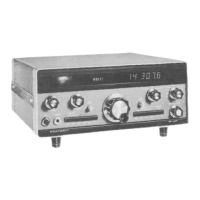The following steps assume that the adjustment signal will
be
furnished by the counter (circuit board A) and that the
S-meter will be used as
a
signal level indicator. You may be
able to improve the filter response to
a
small degree if you
have a signal generator and an audio voltmeter available
which you can substitute as
a
signal source and
a
level
indicator. The signal generator can be connected directly to
the ANT jack and the audio voltmeter across the SPKR
terminals (to provide a
load).
Figure 1-9 (fold-out from Page 240) identifies the trimmer
capacitors to be adjusted for each band switch position.
INSERT THE LONGER INNER LEAD
THROUGH THE PLUG AND WRAP THE
SHIELD LEAD AROUND THE PLUG.
APPLY HEAT TO THE
TIP
OF
THE
PIN ONLY LONG ENOUGH FOR THE
SOLDER TO BE DRAWN UP INTO
THE PIN BY CAPILLARY ACTION
SOLDER THE SHIELD LEAD
ONTO THE PLUG.
CUT OFF EXCESS WIRE
FROM THE TIP
OF
THC PIN.
DLR
.
Figure
1-10
( )
Refer to Figure 1-10 and install a phono plug on the
free end of the
24" shielded cable connected to circuit
board A.
(
)
Insert the phono plug in the ANT jack on the rear
panel (below the heat sink).
(
I
Check that the rear panel antenna switch is in the
CIpJposition.
(
I
Set the front panel controls as follows:
RF Gain Fully clockwise
A LC Depressed
AGC Fast
Band 29.0
Level Fully counterclockwise
9
USB Depressed
ON Depressed
(
)
Tune the Transceiver to the strongest signal in the
vicinity of 29 400 kHz. NOTE: The counter provides
many signals across the band, but the strongest
signiis
-
.~
~-
-....
.---
will be heard at (or near) the
100
kHz pants.
.-..
~.~~~~
~
--
(
)
Refer to Figure 1-9 and adjust the three trimmers for
the 29.0 band to secure the greatest deflection of the
S-meter needle. Repeat the adjustment two or three
times until no greater deflection can be seen.
(
)
Tune to the strongest signal near 29 000 kHz.
(
)
Adjust the Low End trimmer for maximum S-meter
deflection and write down the reading in the margin
opposite this step.
(
)
Turn the BAND
witch to 29.5 and tune to 29 700
kHz.
(
I
Adjust the High End trimmer for maximum S-meter
deflection. Note the meter reading.
(
)
Compare the two S-meter readings and adjust the
trimmers according to the following examples:
Examples:
1. If the meter reading at 29 700 kHz
is
lower than
the 29 000 kHz reading, adjust the Low End
trimmer to increase the meter reading.
2.
If the meter reading at 29 000 kHz
is
lower than
the 29
700
kHz reading, turn the BAND switch
to 29.0 and tune the Transceiver to 29 000 kHz.
Then adjust the High End trimmer to increase
the meter reading.
(
)
Repeat the preceding adjustments two or three times
to secure the most uniform response.
(
)
Turn the BAND switch to 28.0 and tune the
Transceiver for the strongest signal near 28 400 kHz.
(
)
Tune all three trimmers for this band for maximum
S-meter deflection. Repeat the adjustments for the
highest S-meter reading.
(
)
Tune the Transceiver for the strongest signal near
28 000 kHz.
( )
Adjust the Low End trimmer for maximum S-meter
Buttons not mentioned should be released.
deflection and note the meter reading.
I
( )
If not already done, install the extender board and
(
)
Turn the BAND switch to 28.5 and tune the
circuit board G in position
G.
Transceiver to the strongest signal near 29 000 kHz.

